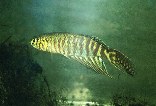| Family: |
Rivulidae (Rivulines), subfamily: Cynolebiinae |
| Max. size: |
6 cm TL (male/unsexed) |
| Environment: |
benthopelagic; freshwater; pH range: 6 - 6.80000019073486; dH range: 8, non-migratory |
| Distribution: |
South America: Atlantic coastal river basins in Brazil. |
| Diagnosis: |
Dorsal soft rays (total): 12-18; Anal soft rays: 19-23; Vertebrae: 28-29. Xenurolebias myersi differs from all other congeners by having the caudal fin sub-lanceolate, never forming a distinctive tip posteriorly in larger individuals (vs. lanceolate, with a pronounced posterior tip) and distinctive light yellow spots on the distal portion of the anal fin in males (vs. light yellow narrow bars). It is also distinguished from X. cricarensis and X. izecksohni in having fewer dark brown bars on the caudal fin in males (4-6, vs. 7-10 in X. cricarensis and 9-12 in X. izecksohni); from X. izecksohni by having fewer dark grey bars on the flank in females (9-11 vs. 12-13), the dorsal fin, in males, with short light bars on the basal portion and small round light spots on the distal portion (vs. branching bars), absence of oblique short bars on the ventral portion of the caudal fin in males (vs. presence), deeper body (29.0-31.4% SL in males and 30.1-33.9% in females, vs. 27.1-28.5% and 28.5-30.6%, respectively), and longer lower jaw (22.4-24.5% of head length in males and 19.6-21.4% iin females, vs. 18.6-20.9% and 17.7-19.7%, respectively); and from X. pataxo in having wider head (71.5-74.6% SL in males and 74.5-81.1% in females, vs. 65.7-71.1% and 65.8-70.3%, respectively), shorter filaments on the dorsall fin in males (reaching between base and middle of the caudal fin, vs. reaching posterior portion of the caudal fin), and the presence of black spots on the posterior part of the caudal peduncle in females (vs. absence) (Ref. 96072).
Description: Dorsal fin with 16-18 rays in males, 12-15 rays in females; anal fin with 20-23 rays in males, 19-22 rays in females; extremity of dorsal fin pointed and long in males, rounded to slightly pointed in females; tip of anal fin pointed in males, rounded in females; and caudal fin sub-lanceolate (Ref. 96072). |
| Biology: |
Found in seasonal pools as well as river floodplains (Ref. 96072). Bottom spawner, 4 months incubation. Is difficult to maintain in aquarium (Ref. 27139). |
| IUCN Red List Status: |
Endangered (EN); Date assessed: 07 November 2018 (B1ab(iii,iv,v)+2ab(iii,iv,v)) Ref. (130435)
|
| Threat to humans: |
harmless |
| Country info: |
|
Source and more info: www.fishbase.org. For personal, classroom, and other internal use only. Not for publication.

